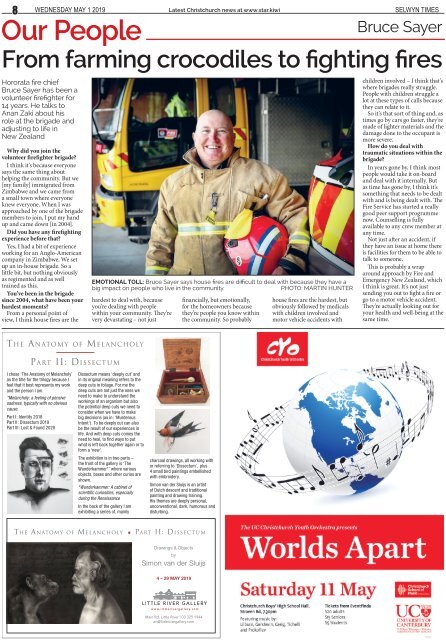Selwyn Times: May 01, 2019
You also want an ePaper? Increase the reach of your titles
YUMPU automatically turns print PDFs into web optimized ePapers that Google loves.
8 Wednesday <strong>May</strong> 1 2<strong>01</strong>9<br />
Latest Christchurch news at www.star.kiwi<br />
Our People<br />
SELWYN TIMES<br />
Bruce Sayer<br />
From farming crocodiles to fighting fires<br />
Hororata fire chief<br />
Bruce Sayer has been a<br />
volunteer firefighter for<br />
14 years. He talks to<br />
Anan Zaki about his<br />
role at the brigade and<br />
adjusting to life in<br />
New Zealand<br />
Why did you join the<br />
volunteer firefighter brigade?<br />
I think it’s because everyone<br />
says the same thing about<br />
helping the community. But we<br />
[my family] immigrated from<br />
Zimbabwe and we came from<br />
a small town where everyone<br />
knew everyone. When I was<br />
approached by one of the brigade<br />
members to join, I put my hand<br />
up and came down [in 2004].<br />
Did you have any firefighting<br />
experience before that?<br />
Yes, I had a bit of experience<br />
working for an Anglo-American<br />
company in Zimbabwe. We set<br />
up an in-house brigade. So a<br />
little bit, but nothing obviously<br />
as regimented and as well<br />
trained as this.<br />
You’ve been in the brigade<br />
since 2004, what have been your<br />
hardest moments?<br />
From a personal point of<br />
view, I think house fires are the<br />
EMOTIONAL TOLL: Bruce Sayer says house fires are difficult to deal with because they have a<br />
big impact on people who live in the community.<br />
PHOTO: MARTIN HUNTER<br />
hardest to deal with, because<br />
you’re dealing with people<br />
within your community. They’re<br />
very devastating – not just<br />
financially, but emotionally,<br />
for the homeowners because<br />
they’re people you know within<br />
the community. So probably<br />
house fires are the hardest, but<br />
obviously followed by medicals<br />
with children involved and<br />
motor vehicle accidents with<br />
children involved – I think that’s<br />
where brigades really struggle.<br />
People with children struggle a<br />
lot at these types of calls because<br />
they can relate to it.<br />
So it’s that sort of thing and, as<br />
times go by cars go faster, they’re<br />
made of lighter materials and the<br />
damage done to the occupant is<br />
more severe.<br />
How do you deal with<br />
traumatic situations within the<br />
brigade?<br />
In years gone by, I think most<br />
people would take it on-board<br />
and deal with it internally. But<br />
as time has gone by, I think it’s<br />
something that needs to be dealt<br />
with and is being dealt with. The<br />
Fire Service has started a really<br />
good peer support programme<br />
now. Counselling is fully<br />
available to any crew member at<br />
any time.<br />
Not just after an accident, if<br />
they have an issue at home there<br />
is facilities for them to be able to<br />
talk to someone.<br />
This is probably a wrap<br />
around approach by Fire and<br />
Emergency New Zealand, which<br />
I think is great. It’s not just<br />
sending you out to fight a fire or<br />
go to a motor vehicle accident.<br />
They’re actually looking out for<br />
your health and well-being at the<br />
same time.<br />
I chose ‘The Anatomy of Melancholy’<br />
as the title for the trilogy because I<br />
feel that it best represents my work<br />
and the person I am.<br />
*Melancholy: a feeling of pensive<br />
sadness, typically with no obvious<br />
cause.<br />
Part I: Identity 2<strong>01</strong>8<br />
Part II: Dissectum 2<strong>01</strong>9<br />
Part III: Lost & Found 2020<br />
Dissectum means ‘deeply cut’ and<br />
in its original meaning refers to the<br />
deep cuts in foliage. For me the<br />
deep cuts are not just the ones we<br />
need to make to understand the<br />
workings of an organism but also<br />
the potential deep cuts we need to<br />
consider when we have to make<br />
big decisions (as in: ‘Murderous<br />
Intent’). To be deeply cut can also<br />
be the result of our experiences in<br />
life. And with deep cuts comes the<br />
need to heal, to find ways to put<br />
what is left back together again or to<br />
form a ‘new’.<br />
The exhibition is in two parts –<br />
the front of the gallery is ‘The<br />
Wunderkammer*’ where various<br />
objects, boxes and other curios are<br />
shown.<br />
*Wunderkammer: A cabinet of<br />
scientific curiosities, especially<br />
during the Renaissance<br />
In the back of the gallery I am<br />
exhibiting a series of, mainly<br />
charcoal drawings, all working with<br />
or referring to ‘Dissectum’, plus<br />
4 small bird paintings embellished<br />
with embroidery.<br />
Simon van der Sluijs is an artist<br />
of Dutch descent and traditional<br />
painting and drawing training.<br />
His themes are deeply personal,<br />
unconventional, dark, humorous and<br />
disturbing.<br />
The AnATomy of melAncholy<br />
PArT II: DIssecT u m<br />
Drawings & Objects<br />
by<br />
Simon van der Sluijs<br />
4 – 29 MAY 2<strong>01</strong>9<br />
Main Rd, Little River | 03 325 1944<br />
art@littlerivergallery.com


















